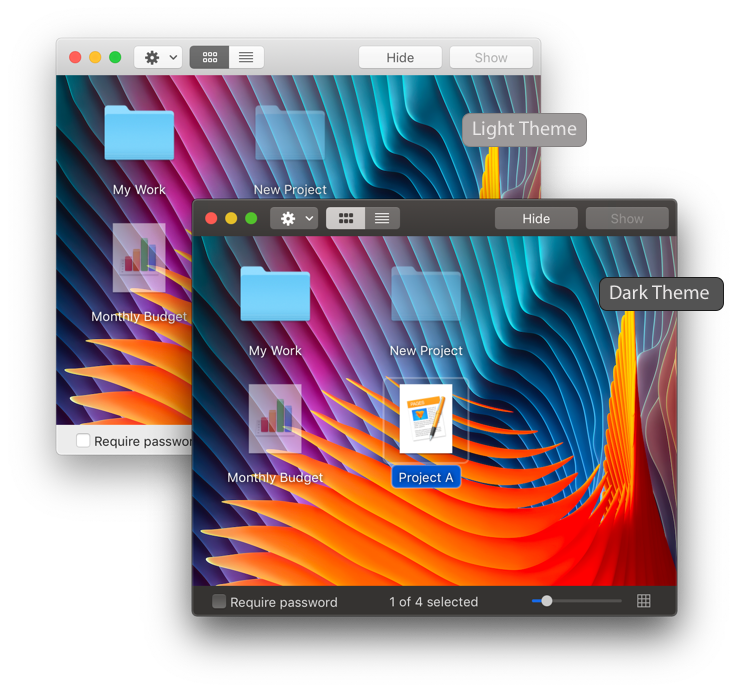Choose what you want to do: Don't show hidden files, folders, or drives will hide the files, folders, and drives that have the hidden attribute toggled on. Show hidden files, folders, and drives lets you see the hidden data. Select OK at the bottom. Here is a list of best free folder hider software for Windows.Install these freeware on your PC and hide your private data. These free folder hider software are designed to hide both files and folders. Hide My Files' clean interface and familiar tree view directory make protecting folders a hassle-free affair. When you lock a folder through the program it replaces its icon with one for the. Key Features & Benefits. Simple and intuitive graphic interface. Block unauthorized access to your files, folders and programs you choose. Lock your folders and files so they can't be accessed, moved, renamed, copied, modified or deleted. Steps to Hide Files and Folders in Windows 10 without using any third party tools. Listed methods use File Properties and Attribute command to Hide Files.
Because I really don’t want to rile up all you wonderful Mac users, I’ve decided to do a follow-up on the whole hiding your folders in plain view dilemma.
If haven’t done so already, be sure to check out my article on how to hide your files, folders, and disk drives; it may not apply to Mojave or whatever else OS you’re running, but at least you’ll get an idea of what you’re up against. So, how do you hide folders on Mac?

Get yourself acquainted with the Terminal (Mac’s version of Windows’ command prompt) because, as it happens, it’s the only way to hide folders on Mac without resorting to third-party tools. Let’s dig in.
How to Hide Folders on Mac – Quick and Painless Version
If you really don’t want to trouble yourself with code, there’s a very easy and extremely fast way to hide your folders on Mac -by using the FileVault.
Basically, it turns your hard-drive in a Fort Knox-like vault which cannot be opened without the proper cipher, which in this case is the username and password associated with your admin account.
Yes, I know it’s like curing the disease by killing the patient, but I did say that it’s the easiest way to go about hiding your folders. Anyway, here’s what you’ll need to do, should you choose to use FileVault for masking your files, folders, and everything in between.
Step 1. Click on the Apple icon located in the upper-left corner of your screen.
Step 2. Click on System Preferences.
Step 3. Click on Security & Privacy.
Step 4. Head to the FileVault tab (it’s right next to the General tab).
Step 5. Click on the padlock icon to make changes.
Step 6. Click on the Turn On FileVault button.
Step 7. In the next dialog box, select the recovery method. You can choose between iCloud and generating a local recovery key. I, for one, would go with the later version since it’s more secure (no use compromising two accounts if your password gets stolen).
Here’s what’s going to happen if you use the local recovery key method: you will be taken to another dialog box where you will be going to see a system-generated code.
It looks very much like a Windows or antivirus activation key. Put this code in a new document or something. That the recovery key you’ll be using in case you don’t remember the password.
Step 8. Click on Continue.
Step 9. Click again on the Continue button to finish the process.
That’s it! Now FileVault will begin encrypting all the data on your drive. Depending on your specs, this process can take anywhere from a couple of hours to a few days.
Don’t worry too much about ending up with a potato computer; you’ll still be able to surf the web, watch movies, or play games because everything happens in the background.
One more thing: don’t forget to hook up your Mac to the power outlet. You really wouldn’t want to run out of juice in the middle of a procedure involving the drive on which your entire data is stored.
SECURE YOUR ONLINE BROWSING!
Get Threat Prevention HomeHow to hide folders on Mac using Terminal
There’s also a way to hide folders on Mac, but it involves using the Terminal. Don’t worry; it’s just a couple of command lines. Nothing too fancy or complicated. So, here’s how to hide files/folders using Terminal.
Step 1. Click on Finder.
Step 2. From the left panel, select Applications.


Step 3. Scroll down until you see Utilities. Double-click to enter the Utilities menu.
Step 4. Double-click on Terminal.
Step 5. Type in the following line:
Step 6. Create a new folder on your desktop. Fill it with stuff that you want to hide.
Step 7. Drag-and-drop the folder on to the Terminal window. If you look closely, you’ll see that the folder’s path has appeared.
Step 8. Press Return to hide the folder.
Great! Now that your folder’s out of sight, out of mind, let’s see how we go about accessing it. There are three ways to access hidden files and folders.
Method 1 – Using the Go to Folder function
From the Go menu, select Go to Folder. In the dialog box that appears on your screen, type in the path of your hidden folder. Don’t forget to include the “~” sign before the path.
It should look something like this: “~/Desktop/MyHiddenFiles”

Method 2 – Using the Open/Dialog function
Double-click on Finder and select Desktop from Favorites. Press the Show items as icons, in a list, in columns, or in the library (the pictogram looks like a rectangle divided by to straight lines). You may need to perform this operation a couple of times before the folder becomes visible.
Method 3 – Show hidden files in Finder
It’s possible to see a hidden file in Finder, but you will need to tinker a bit with Terminal. So, fire up your Terminal, and type in the following line:
Press Return to continue. After that, please type in or paste the following line:
Again, press return, go to Finder, and there you are – what was once hidden, can now be seen. Enjoy!
Hide Folders V3
How to hide folders on your Mac by using Terminal Aliases
Aliases are macros or shortcuts to various commands. Albeit temporary, we can easily turn this into a more permanent solution. Again, you will need to fiddle around with the Terminal. So, here’s what you’ll need to do:
Step 1. Open the Terminal.
Step 2. Type in or paste the following line:
Step 3. When prompted, type in the username and password associated with your active admin account.
Hidden Folders Windows 10
Step 4. Press Return to continue.
Step 5. Scroll down to the end of the open .bash_profile.
Step 6. Type in or paste the following line:
Step 7. Navigate to the following line and type in or paste the following:
Step 8. Save the file.
Step 9. Exit Terminal.
That’s about it. Now, the next time you will launch Finder, all desired folders will be hidden.
Even more ways to hide files and folders on your Mac
As they say, there’s more than one way to skin something (please don’t say “cat”). So, if you found that the methods described are much too difficult, here are a couple of more ways to hide folders on Mac.
Using the “mv” command
The “mv” command in Terminal moves a file or folder from one place to another. How does this help you? Here’s the trick: the “mv” command moves the folder from its original location to a period folder.
Now, by default, period folders are hidden because they contain system-critical information. Basically, it’s the same thing as moving files or folders to your System32 folder in Windows.
To make files invisible in this manner, open Terminal and type in mv filename .filename. Replace “filename” with the name of the file you want to hide and the “.filename” parameter with the name of the system-protect file.
Deploy Apple’s Developer Tools
If you’re in the mood to do a bit of tweaking, download and deploy one of Apple’s Dev Tools and enter the following command in Terminal: setfile -a V <name of the file you want to hide>. The name of the file should follow the “V” parameter without the “<>”. This command will set the file’s attribute to invisible.
Dump everything in the Library folder
When everything else fails, try the Library folder. It’s hidden by default, making it the ideal place to store top-secret stuff. Just fire up your Finder, navigate to Finder, right-click, create a new folder, and drag all the files in there.
Use third-party file-hiding software
You can also use special software to keep your folders away from prying eyes. The best ones are Altomac and Hide Folders. However, there are also open-source alternatives such as AES Crypt, Axcrypt, or File Lock PE. Give them a try if you’re looking to beef up your account’s privacy.
Wrap-up
That’s it on how to hide folders on Mac computer. Know any more methods? Hit the comments section and let me know.
Hide Folders Software
Why do you need Free Hide Folder?

Most people have many files or folders on their computer which they do not want to others see or use them. If you are interested in protecting your personal information, Free Hide Folder is just what you are searching for. With Free Hide Folder you will protect your files avoiding them to be being modified, seen or erased by other users.
How To Find Hidden Folders
Platform: Windows 9x/Me/NT/2000/XP/2003/Vista/7/8/10
File Size: 876 KB
License: Freeware
Download and use for free
Show Hidden
Using Free Hide Folder
It's actually very easy to hide a folder with Free Hide Folder. It takes only a few mouse clicks. First, you need to run Free Hide Folder, locate and select the folder you want to hide, and then click Hide Folder button to hide folders.
Key Features:
• Hide your folder completely. Unless you unhide it yourself, nobody can find it.
• Password protection when running program.
• No file system structure modifications needed.
• Any number of folders may be hidden at the same time.
• Easy-to-use user interface.
• 100% Spyware FREE. This software does NOT contain any Spyware, Adware or Viruses.
